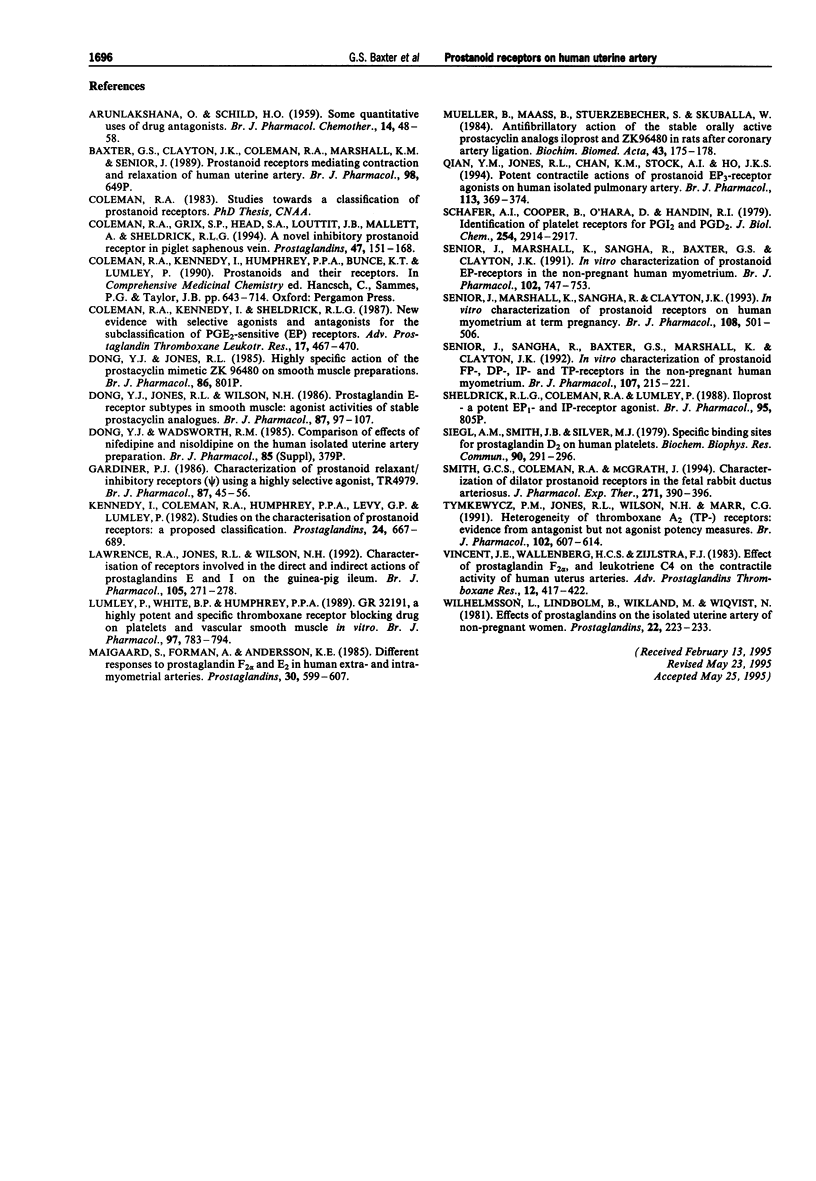Abstract
1. This study was undertaken to characterize pharmacologically the prostanoid receptor subtypes mediating constriction and relaxation of human isolated uterine artery. 2. U-46619 was a potent constrictor agonist on human uterine artery (EC50 [95% CL] = 3.5 [1.8-6.7] nM). Prostaglandin E2 (PGE2), PGF2 alpha, PGD2 and PGI2 only weakly constricted the uterine artery, being at least 100 times less potent than U-46619. The PGE2 and PGI2 constrictor effects may be modified by the potent dilator effects of these compounds. A number of agonists which show selectivity for FP-, DP- and EP-receptors including ICI 81008, BW 245C, sulprostone, rioprostil and butaprost, failed to cause any constriction at concentrations up to 30 microM. 3. Constrictor responses induced by all agonists tested were reduced or abolished by the TP-receptor blocking drugs, GR 32191 and EP 092. pA2 estimates for both antagonists versus U-46619 were 8.50, values which are consistent with their affinities at TP-receptors. 4. In preparations pre-constricted with phenylephrine (1 microM) both PGI2 and PGE2 were potent relaxant agonists. The selective IP-receptor agonists, cicaprost and iloprost, also dilated human uterine artery and were approximately 10 fold more potent than PGI2. The EP2-receptor agonists, butaprost and rioprostil and the selective DP-agonist, BW 245C, were at least 100 fold weaker than PGI2 and PGE2 suggesting that neither DP- nor EP2 receptors were involved. 5. We conclude that TP-receptors mediate constriction, whereas IP- and possibly EP4-receptors mediate relaxation of human uterine artery.
Full text
PDF




Selected References
These references are in PubMed. This may not be the complete list of references from this article.
- ARUNLAKSHANA O., SCHILD H. O. Some quantitative uses of drug antagonists. Br J Pharmacol Chemother. 1959 Mar;14(1):48–58. doi: 10.1111/j.1476-5381.1959.tb00928.x. [DOI] [PMC free article] [PubMed] [Google Scholar]
- Coleman R. A., Grix S. P., Head S. A., Louttit J. B., Mallett A., Sheldrick R. L. A novel inhibitory prostanoid receptor in piglet saphenous vein. Prostaglandins. 1994 Feb;47(2):151–168. doi: 10.1016/0090-6980(94)90084-1. [DOI] [PubMed] [Google Scholar]
- Coleman R. A., Kennedy I., Sheldrick R. L. New evidence with selective agonists and antagonists for the subclassification of PGE2-sensitive (EP) receptors. Adv Prostaglandin Thromboxane Leukot Res. 1987;17A:467–470. [PubMed] [Google Scholar]
- Dong Y. J., Jones R. L., Wilson N. H. Prostaglandin E receptor subtypes in smooth muscle: agonist activities of stable prostacyclin analogues. Br J Pharmacol. 1986 Jan;87(1):97–107. doi: 10.1111/j.1476-5381.1986.tb10161.x. [DOI] [PMC free article] [PubMed] [Google Scholar]
- Gardiner P. J. Characterization of prostanoid relaxant/inhibitory receptors (psi) using a highly selective agonist, TR4979. Br J Pharmacol. 1986 Jan;87(1):45–56. doi: 10.1111/j.1476-5381.1986.tb10155.x. [DOI] [PMC free article] [PubMed] [Google Scholar]
- Kennedy I., Coleman R. A., Humphrey P. P., Levy G. P., Lumley P. Studies on the characterisation of prostanoid receptors: a proposed classification. Prostaglandins. 1982 Nov;24(5):667–689. doi: 10.1016/0090-6980(82)90036-3. [DOI] [PubMed] [Google Scholar]
- Lawrence R. A., Jones R. L., Wilson N. H. Characterization of receptors involved in the direct and indirect actions of prostaglandins E and I on the guinea-pig ileum. Br J Pharmacol. 1992 Feb;105(2):271–278. doi: 10.1111/j.1476-5381.1992.tb14245.x. [DOI] [PMC free article] [PubMed] [Google Scholar]
- Lumley P., White B. P., Humphrey P. P. GR32191, a highly potent and specific thromboxane A2 receptor blocking drug on platelets and vascular and airways smooth muscle in vitro. Br J Pharmacol. 1989 Jul;97(3):783–794. doi: 10.1111/j.1476-5381.1989.tb12017.x. [DOI] [PMC free article] [PubMed] [Google Scholar]
- Maigaard S., Forman A., Andersson K. E. Different responses to prostaglandin F2 alpha and E2 in human extra- and intramyometrial arteries. Prostaglandins. 1985 Oct;30(4):599–607. doi: 10.1016/0090-6980(85)90024-3. [DOI] [PubMed] [Google Scholar]
- Qian Y. M., Jones R. L., Chan K. M., Stock A. I., Ho J. K. Potent contractile actions of prostanoid EP3-receptor agonists on human isolated pulmonary artery. Br J Pharmacol. 1994 Oct;113(2):369–374. doi: 10.1111/j.1476-5381.1994.tb16997.x. [DOI] [PMC free article] [PubMed] [Google Scholar]
- Schafer A. I., Cooper B., O'Hara D., Handin R. I. Identification of platelet receptors for prostaglandin I2 and D2. J Biol Chem. 1979 Apr 25;254(8):2914–2917. [PubMed] [Google Scholar]
- Senior J., Marshall K., Sangha R., Baxter G. S., Clayton J. K. In vitro characterization of prostanoid EP-receptors in the non-pregnant human myometrium. Br J Pharmacol. 1991 Mar;102(3):747–753. doi: 10.1111/j.1476-5381.1991.tb12244.x. [DOI] [PMC free article] [PubMed] [Google Scholar]
- Senior J., Marshall K., Sangha R., Clayton J. K. In vitro characterization of prostanoid receptors on human myometrium at term pregnancy. Br J Pharmacol. 1993 Feb;108(2):501–506. doi: 10.1111/j.1476-5381.1993.tb12832.x. [DOI] [PMC free article] [PubMed] [Google Scholar]
- Senior J., Sangha R., Baxter G. S., Marshall K., Clayton J. K. In vitro characterization of prostanoid FP-, DP-, IP- and TP-receptors on the non-pregnant human myometrium. Br J Pharmacol. 1992 Sep;107(1):215–221. doi: 10.1111/j.1476-5381.1992.tb14489.x. [DOI] [PMC free article] [PubMed] [Google Scholar]
- Siegl A. M., Smith J. B., Silver M. J. Specific binding sites for prostaglandin D2 on human platelets. Biochem Biophys Res Commun. 1979 Sep 12;90(1):291–296. doi: 10.1016/0006-291x(79)91623-1. [DOI] [PubMed] [Google Scholar]
- Smith G. C., Coleman R. A., McGrath J. C. Characterization of dilator prostanoid receptors in the fetal rabbit ductus arteriosus. J Pharmacol Exp Ther. 1994 Oct;271(1):390–396. [PubMed] [Google Scholar]
- Tymkewycz P. M., Jones R. L., Wilson N. H., Marr C. G. Heterogeneity of thromboxane A2 (TP-) receptors: evidence from antagonist but not agonist potency measurements. Br J Pharmacol. 1991 Mar;102(3):607–614. doi: 10.1111/j.1476-5381.1991.tb12220.x. [DOI] [PMC free article] [PubMed] [Google Scholar]
- Vincent J. E., Wallenburg H. C., Zijlstra F. J. Effect of prostaglandin F2 alpha, prostacyclin, and leukotriene C4 on the contractile activity of human uterine arteries. Adv Prostaglandin Thromboxane Leukot Res. 1983;12:417–422. [PubMed] [Google Scholar]
- Wilhelmsson L., Lindblom B., Wikland M., Wiqvist N. Effects of prostaglandins on the isolated uterine artery of nonpregnant women. Prostaglandins. 1981 Aug;22(2):223–233. doi: 10.1016/0090-6980(81)90037-x. [DOI] [PubMed] [Google Scholar]
- Williams T. L., Smith D. A., Burton N. R., Stone T. W. Amino acid pharmacology in neocortical slices: evidence for bimolecular actions from an extension of the Hill and Gaddum-Schild equations. Br J Pharmacol. 1988 Nov;95(3):805–810. doi: 10.1111/j.1476-5381.1988.tb11708.x. [DOI] [PMC free article] [PubMed] [Google Scholar]


